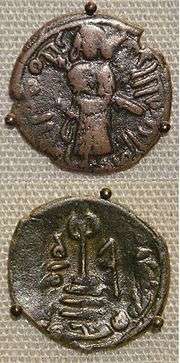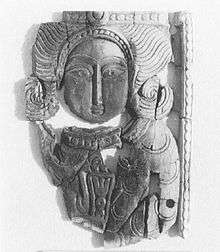Umayyad Caliphate
The Umayyad Caliphate (661–750 CE; UK: /ʊˈmaɪjæd, uːˈ-/,[2] US: /uːˈmaɪ(j)əd, -aɪæd/;[3][4][5] Arabic: ٱلْخِلَافَة ٱلْأُمَوِيَّة, romanized: al-Khilāfah al-ʾUmawīyah)[6] was the second of the four major caliphates established after the death of Muhammad. The caliphate was ruled by the Umayyad dynasty (Arabic: ٱلْأُمَوِيُّون, al-ʾUmawīyūn, or بَنُو أُمَيَّة, Banū ʾUmayyah, "Sons of Umayyah"). The third Caliph of Rashidun Caliphate, Uthman ibn Affan (r. 644–656), was also a member of the Umayyad clan. The family established dynastic, hereditary rule with Muawiya ibn Abi Sufyan, long-time governor of al-Sham (Greater Syria), who became the sixth Caliph after the end of the First Muslim Civil War in 661. After Mu'awiyah's death in 680, conflicts over the succession resulted in a Second Civil War[7] and power eventually fell into the hands of Marwan I from another branch of the clan. The region of Syria remained the Umayyads' main power base thereafter, and Damascus was their capital.
Umayyad Caliphate ٱلْخِلَافَة ٱلْأُمَوِيَّة | |||||||||||||||||||||||||||||||
|---|---|---|---|---|---|---|---|---|---|---|---|---|---|---|---|---|---|---|---|---|---|---|---|---|---|---|---|---|---|---|---|
| 661–750 | |||||||||||||||||||||||||||||||
 The Umayyad flag color was white. | |||||||||||||||||||||||||||||||
 The Umayyad Caliphate at its greatest extent in AD 750 | |||||||||||||||||||||||||||||||
| Capital | |||||||||||||||||||||||||||||||
| Capital-in-exile | Córdoba (756–1031) | ||||||||||||||||||||||||||||||
| Common languages | Classical Arabic (official) – Coptic, Greek, Latin, Persian (official in certain regions until the reign of Abd al-Malik) – Aramaic, Armenian, Kurdish, Berber languages, African Romance, Mozarabic, Sindhi, Georgian, Prakrit | ||||||||||||||||||||||||||||||
| Religion | Islam | ||||||||||||||||||||||||||||||
| Government | Caliphate | ||||||||||||||||||||||||||||||
| Caliph | |||||||||||||||||||||||||||||||
• 661–680 | Muawiya I (first) | ||||||||||||||||||||||||||||||
• 744–750 | Marwan II (last) | ||||||||||||||||||||||||||||||
| History | |||||||||||||||||||||||||||||||
• Muawiya I becomes Caliph | estimated from 660 to 665 | ||||||||||||||||||||||||||||||
| 750 | |||||||||||||||||||||||||||||||
| Area | |||||||||||||||||||||||||||||||
| 720 | 11,100,000[1] km2 (4,300,000 sq mi) | ||||||||||||||||||||||||||||||
| Currency | |||||||||||||||||||||||||||||||
| |||||||||||||||||||||||||||||||
| Caliphate خِلافة |
|---|
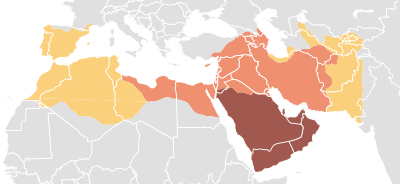 |
|
Main caliphates |
|
Parallel caliphates |
|
|
| Historical Arab states and dynasties | ||||||||||||||||||||||||||||||||||||||||||||||||||||||||||
|---|---|---|---|---|---|---|---|---|---|---|---|---|---|---|---|---|---|---|---|---|---|---|---|---|---|---|---|---|---|---|---|---|---|---|---|---|---|---|---|---|---|---|---|---|---|---|---|---|---|---|---|---|---|---|---|---|---|---|
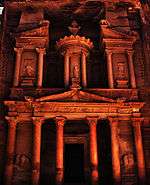 | ||||||||||||||||||||||||||||||||||||||||||||||||||||||||||
|
Ancient Arab States
|
||||||||||||||||||||||||||||||||||||||||||||||||||||||||||
|
Arab Empires
|
||||||||||||||||||||||||||||||||||||||||||||||||||||||||||
|
Eastern Dynasties
|
||||||||||||||||||||||||||||||||||||||||||||||||||||||||||
|
Western Dynasties
|
||||||||||||||||||||||||||||||||||||||||||||||||||||||||||
|
Arabian Peninsula
|
||||||||||||||||||||||||||||||||||||||||||||||||||||||||||
|
East Africa
|
||||||||||||||||||||||||||||||||||||||||||||||||||||||||||
|
Current monarchies
|
||||||||||||||||||||||||||||||||||||||||||||||||||||||||||
The Umayyads continued the Muslim conquests, incorporating the Transoxiana, Sindh, the Maghreb and the Iberian Peninsula (Al-Andalus) into the Muslim world. At its greatest extent, the Umayyad Caliphate covered 11,100,000 km2 (4,300,000 sq mi),[1] making it one of the largest empires in history in terms of area. The dynasty was eventually overthrown by a rebellion led by the Abbasids in 750. Survivors of the dynasty established themselves in Cordoba which, in the form of an Emirate and then a Caliphate, became a world centre[8][9] of science, medicine, philosophy and invention, ushering in the period of the Golden Age of Islam.
The Umayyad caliphate ruled over a vast multiethnic and multicultural population. Christians, who still constituted a majority of the Caliphate's population, and Jews were allowed to practice their own religion but had to pay a head tax (the jizya) from which Muslims were exempt.[10] There was, however, the Muslim-only zakat tax, which was earmarked explicitly for various welfare programmes.[10][11] Prominent positions were held by Christians, some of whom belonged to families that had served in Byzantine governments. The employment of Christians was part of a broader policy of religious accommodation that was necessitated by the presence of large Christian populations in the conquered provinces, as in Syria. This policy also boosted Muawiya's popularity and solidified Syria as his power base.[12][13]
History
Origins
Early influence
During the pre-Islamic period, the Umayyads or "Banu Umayya" were a leading clan of the Quraysh tribe of Mecca.[14] By the end of the 6th century, the Umayyads dominated the Quraysh's increasingly prosperous trade networks with Syria and developed economic and military alliances with the nomadic Arab tribes that controlled the northern and central Arabian desert expanses, affording the clan a degree of political power in the region.[15] The Umayyads under the leadership of Abu Sufyan ibn Harb were the principal leaders of Meccan opposition to the Islamic prophet Muhammad, but after the latter captured Mecca in 630, Abu Sufyan and the Quraysh embraced Islam.[16][17] To reconcile his influential Qurayshite tribesmen, Muhammad gave his former opponents, including Abu Sufyan, a stake in the new order.[18][19][20] Abu Sufyan and the Umayyads relocated to Medina, Islam's political centre, to maintain their new-found political influence in the nascent Muslim community.[21]
Muhammad's death in 632 left open the succession of leadership of the Muslim community.[22] Leaders of the Ansar, the natives of Medina who had provided Muhammad safe haven after his emigration from Mecca in 622, discussed forwarding their own candidate out of concern that the Muhajirun, Muhammad's early followers and fellow emigrants from Mecca, would ally with their fellow tribesmen from the former Qurayshite elite and take control of the Muslim state.[23] The Muhajirun gave allegiance to one of their own, the early, elderly companion of Muhammad, Abu Bakr, and put an end to Ansarite deliberations.[24] Abu Bakr was viewed as acceptable by the Ansar and the Qurayshite elite and was acknowledged as caliph (leader of the Muslim community).[25] He showed favor to the Umayyads by awarding them command roles in the Muslim conquest of Syria. One of the appointees was Yazid, the son of Abu Sufyan, who owned property and maintained trade networks in Syria.[26][27]
Abu Bakr's successor Umar (r. 634–644) curtailed the influence of the Qurayshite elite in favor of Muhammad's earlier supporters in the administration and military, but nonetheless allowed the growing foothold of Abu Sufyan's sons in Syria, which was all but conquered by 638.[28] When Umar's overall commander of the province Abu Ubayda ibn al-Jarrah died in 639, he appointed Yazid governor of Syria's Damascus, Palestine and Jordan districts.[28] Yazid died shortly after and Umar appointed his brother Mu'awiya in his place.[29] Umar's exceptional treatment of Abu Sufyan's sons may have stemmed from his respect for the family, their burgeoning alliance with the powerful Banu Kalb tribe as a counterbalance to the influential Himyarite settlers in Homs who viewed themselves as equals to the Quraysh in nobility or the lack of a suitable candidate at the time, particularly amid the plague of Amwas which had already killed Abu Ubayda and Yazid.[29] Under Mu'awiya's stewardship, Syria remained domestically peaceful, organized and well-defended from its former Byzantine rulers.[30]
Caliphate of Uthman
Umar's successor, Uthman ibn Affan, was a wealthy Umayyad and early Muslim convert with marital ties to Muhammad.[31] He was elected by the shura council, composed of Muhammad's cousin Ali, al-Zubayr ibn al-Awwam, Talha ibn Ubayd Allah, Sa'd ibn Abi Waqqas and Abd al-Rahman ibn Awf, all of whom were close, early companions of Muhammad and belonged to the Quraysh.[31][32] He was chosen over Ali because he would ensure the concentration of state power into the hands of the Quraysh, as opposed to Ali's determination to diffuse power among all of the Muslim factions.[33] From early in his reign, Uthman displayed explicit favouritism to his kinsmen, in stark contrast to his predecessors.[31][32] He appointed his family members as governors over the regions successively conquered under Umar and himself, namely much of the Sasanian Empire, i.e. Iraq and Iran, and the former Byzantine territories of Syria and Egypt.[32] In Medina, he relied extensively on the counsel of his Umayyad cousins, the brothers al-Harith and Marwan ibn al-Hakam.[34] According to the historian Wilferd Madelung, this policy stemmed from Uthman's "conviction that the house of Umayya, as the core clan of Quraysh, was uniquely qualified to rule in the name of Islam".[31]
Uthman's nepotism provoked the ire of the Ansar and the members of the shura.[31][32] In 645/46, he added the Jazira (Upper Mesopotamia) to Mu'awiya's Syrian governorship and granted the latter's request to take possession of all Byzantine crown lands in Syria to help pay his troops.[35] He had the surplus taxes from the wealthy provinces of Kufa and Egypt forwarded to the treasury in Medina, which he used at his personal disposal, frequently disbursing its funds and war booty to his Umayyad relatives.[36] Moreover, the lucrative Sasanian crown lands of Iraq, which Umar had designated as communal property for the benefit of the Arab garrison towns of Kufa and Basra, were turned into caliphal crown lands to be used at Uthman's discretion.[37] Mounting resentment against Uthman's rule in Iraq and Egypt and among the Ansar and Quraysh of Medina culminated in the siege and killing of the caliph in 656. In the assessment of the historian Hugh N. Kennedy, Uthman was killed because of his determination to centralize control over the Caliphate's government by the traditional elite of the Quraysh, particularly his Umayyad clan, which he believed possessed the "experience and ability" to govern, at the expense of the interests, rights and privileges of many early Muslims.[34]
First Fitna
After Uthman's assassination, Ali was recognized as caliph in Medina, though his support stemmed from the Ansar and the Iraqis, while the bulk of the Quraysh were wary of his rule.[34][38] The first challenge to his authority came from the Qurayshite leaders al-Zubayr and Talha, who had opposed Uthman's empowerment of the Umayyad clan but feared that their own influence and the power of the Quraysh in general would dissipate under Ali.[39][40] Backed by one of Muhammad's wives, A'isha, they attempted to rally support against Ali among the troops of Basra, prompting the caliph to leave for Iraq's other garrison town, Kufa, where he could better confront his challengers.[41] Ali defeated them at the Battle of the Camel, in which al-Zubayr and Talha were slain and A'isha consequently entered self-imposed seclusion.[41][42] Ali's sovereignty was thereafter recognized in Basra and Egypt and he established Kufa as the Caliphate's new capital.[42]
Although Ali was able to replace Uthman's governors in Egypt and Iraq with relative ease, Mu'awiya had developed a solid power-base and an effective military against the Byzantines from the Arab tribes of Syria.[41] Mu'awiya did not claim the caliphate, but was determined to retain control of Syria and opposed Ali in the name of avenging his kinsman Uthman, accusing the caliph of culpability in his death.[43][44][45] Ali and Mu'awiya fought to a stalemate at the Battle of Siffin in early 657. Ali agreed to settle the matter with Mu'awiya by arbitration, though the talks failed to achieve a resolution.[46] The decision to arbitrate fundamentally weakened Ali's political position as he was forced to negotiate with Mu'awiya on equal terms, while it drove a significant number of his supporters, who became known as the Kharijites, to revolt.[47] Ali's coalition steadily disintegrated and many Iraqi tribal nobles secretly defected to Mu'awiya, while the latter's ally Amr ibn al-As ousted Ali's governor from Egypt in July 658.[46][48] In July 660 Mu'awiya was formally recognized as caliph in Jerusalem by his Syrian tribal allies.[46] Ali was assassinated by a Kharijite in January 661.[49] His son Hasan succeeded him, but abdicated in return for compensation upon Mu'awiya's arrival to Iraq with his Syrian army in the summer.[46] At that point, Mu'awiya entered Kufa and received the allegiance of the Iraqis.[50]
Sufyanid period
Caliphate of Mu'awiya

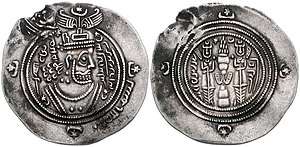
The recognition of Mu'awiya in Kufa, referred to as the "year of unification of the community" in the Muslim traditional sources, is generally considered the start of his caliphate.[46] With his accession, the political capital and the caliphal treasury were transferred to Damascus, the seat of Mu'awiya's power.[51] Syria's emergence as the metropolis of the Umayyad Caliphate was the result of Mu'awiya's twenty-year entrenchment in the province, the geographic distribution of its relatively large Arab population throughout the province in contrast to their seclusion in garrison cities in other provinces, and the domination of a single tribal confederation, the Kalb-led Quda'a, as opposed to the wide array of competing tribal groups in Iraq.[52] These long-established, formerly Christian Arab tribes in Syria, having been integrated into the military of the Byzantine Empire and their Ghassanid client kings, were "more accustomed to order and obedience" than their Iraqi counterparts, according to the historian Julius Wellhausen.[53] Mu'awiya relied on the powerful Kalbite chief Ibn Bahdal and the Kindite nobleman Shurahbil ibn Simt alongside the Qurayshite commanders al-Dahhak ibn Qays al-Fihri and Abd al-Rahman, the son of the prominent general Khalid ibn al-Walid, to guarantee the loyalty of the key military components of Syria.[54] Mu'awiya preoccupied his core Syrian troops in nearly annual or bi-annual land and sea raids against Byzantium, which provided them with battlefield experience and war spoils, but secured no permanent territorial gains.[55] Toward the end of his reign the caliph entered a thirty-year truce with Byzantine emperor Constantine IV (r. 668–685),[56] obliging the Umayyads to pay the Empire an annual tribute of gold, horses and slaves.[57]
Mu'awiya's principal challenge was reestablishing the unity of the Muslim community and asserting the credibility of the Caliphate and his own power across the provinces amid the political and social disintegration of the First Fitna.[58] There remained significant opposition to his assumption of the caliphate and a strong central government in general.[59] The garrison towns of Kufa and Basra, populated by the Arab immigrants and troops who arrived during the conquest of Iraq in the 630s–640s, resented the transition of power to Syria.[60] They remained divided, nonetheless, as both cities competed for power and influence in Iraq and its eastern dependencies and remained divided between the Arab tribal nobility and the early Muslim converts, the latter of whom were divided between the pro-Alids (loyalists of Ali) and the Kharijites, who followed their own strict interpretation of Islam.[60] The caliph applied a decentralized approach to governing Iraq by forging alliances with its tribal nobility, such as the Kufan leader al-Ash'ath ibn Qays, and entrusting the administration of Kufa and Basra to highly experienced members of the Thaqif tribe, al-Mughira ibn Shu'ba and the latter's protege Ziyad ibn Abihi (whom Mu'awiya adopted as his half-brother), respectively.[61] In return for recognizing his suzerainty, maintaining order and the forwarding of a relatively token portion of the provincial tax revenues to Damascus, the caliph let his governors rule with practical independence.[60] After al-Mughira's death in 670, Mu'awiya attached Kufa and its dependencies to the governorship of Basra, making Ziyad the practical viceroy over the eastern half of the Caliphate.[62] Afterward, Ziyad launched a concerted campaign to firmly establish Arab rule in the massive Khurasan region east of Iran and restart the Muslim conquests in the surrounding areas.[63] Not long after Ziyad's death, he was succeeded by his son Ubayd Allah.[63] Meanwhile, Amr ibn al-As ruled Egypt from the provincial capital of Fustat as a virtual partner of Mu'awiya until his death in 663, after which loyalist governors were appointed and the province became a practical appendage of Syria.[64] Under Mu'awiya's direction, the Muslim conquest of Ifriqiya (central North Africa) was launched by the commander Uqba ibn Nafi in 670, which extended Umayyad control as far as Byzacena (modern southern Tunisia), where Uqba founded the permanent Arab garrison city of Kairouan.[65][66]
Succession of Yazid I and collapse of Sufyanid rule
In contrast to Uthman, Mu'awiya restricted the influence of his Umayyad kinsmen to the governorship of Medina, where the dispossessed Islamic elite, including the Umayyads, were suspicious or hostile toward his rule.[60][67] However, in an unprecedented move in Islamic politics, Mu'awiya nominated his own son, Yazid I, as his successor in 676, introducing hereditary rule to caliphal succession and, in practice, turning the office of the caliph into a kingship.[68] The act was met with disapproval or opposition by the Iraqis and the Hejaz-based Quraysh, including the Umayyads, but most were bribed or coerced into acceptance.[69] Yazid acceded after Mu'awiya's death in 680 and almost immediately faced a challenge to his rule by the Kufan partisans of Ali who had invited Ali's son and Muhammad's grandson Husayn to stage a revolt against Umayyad rule from Iraq.[70] An army mobilized by Iraq's governor Ubayd Allah intercepted and killed Husayn outside Kufa at the Battle of Karbala. Although it stymied active opposition to Yazid in Iraq, the killing of Muhammad's grandson left many Muslims outraged and significantly increased Kufan hostility toward the Umayyads and sympathy for the family of Ali.[71]
The next major challenge to Yazid's rule emanated from the Hejaz where Abd Allah ibn al-Zubayr, the son of al-Zubayr ibn al-Awwam and grandson of Abu Bakr, advocated for a shura among the Quraysh to elect the caliph and rallied opposition to the Umayyads from his headquarters in Islam's holiest sanctuary, the Ka'aba in Mecca.[71] The Ansar and Quraysh of Medina also took up the anti-Umayyad cause and in 683 expelled the Umayyads from the city.[72] Yazid's Syrian troops routed the Medinese at the Battle of al-Harra and subsequently plundered Medina before besieging Ibn al-Zubayr in Mecca.[73] The Syrians withdrew upon news of Yazid's death in 683, after which Ibn al-Zubayr declared himself caliph and soon after gained recognition in most provinces of the Caliphate, including Iraq and Egypt.[74] In Syria Ibn Bahdal secured the succession of Yazid's son and appointed successor Mu'awiya II, whose authority was likely restricted to Damascus and Syria's southern districts.[73][75] Mu'awiya II had been ill from the beginning of his accession, with al-Dahhak assuming the practical duties of his office, and he died in early 684 without naming a successor.[76] His death marked the end of the Umayyads' Sufyanid ruling house, called after Mu'awiya I's father Abu Sufyan.[77] The eldest surviving Sufyanid, al-Walid ibn Utba, the son of Mu'awiya I's full brother, died shortly after Mu'awiya II's death, while another paternal uncle of the deceased caliph, Uthman ibn Anbasa ibn Abi Sufyan, who had support from the Kalb of the Jordan district, recognized the caliphate of his maternal uncle Ibn al-Zubayr.[75] Ibn Bahdal favored Mu'awiya II's brothers Khalid and Abd Allah for the succession, but they were viewed as too young and inexperienced by most of the pro-Umayyad tribal nobility in Syria.[78][79]
Early Marwanid period
Marwanid transition and end of Second Fitna
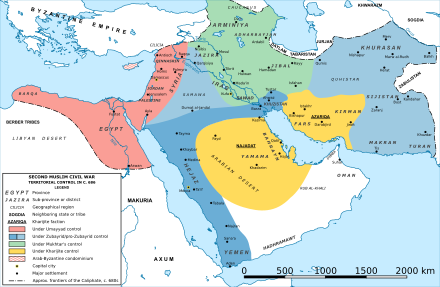
Umayyad authority nearly collapsed in their Syrian stronghold after the death of Mu'awiya II.[80] Al-Dahhak, who controlled Damascus, the Qays tribes, which dominated the Qinnasrin district (northern Syria) and the Jazira, the Judham, the dominant tribe in Palestine, and the Ansar and South Arabian tribes, which collectively dominated Homs, all opted to recognize Ibn al-Zubayr.[81] Marwan ibn al-Hakam, the leader of the Umayyads expelled to Syria from Medina, was prepared to submit to Ibn al-Zubayr as well, but was instead persuaded to forward his candidacy for the caliphate by Ubayd Allah, who had fled to Syria after being driven out of Iraq and strove to uphold Umayyad rule.[80] During a summit of pro-Umayyad Syrian tribes, namely the Quda'a and their Kindite allies, organized by Ibn Bahdal in the old Ghassanid capital of Jabiya, Marwan was elected caliph in exchange for economic privileges to the loyalist tribesmen.[78][82] At the subsequent Battle of Marj Rahit in August 684, Marwan led his tribal allies to a decisive victory against a much larger Qaysite army led by al-Dahhak, who was slain.[78] Not long afterward, the South Arabians of Homs and the Judham joined the Quda'a to form the tribal confederation of Yaman.[82] Marj Rahit led to the long-running conflict between the Qays and Yaman coalitions as the former regrouped in the Euphrates river fortress of Circesium under Zufar ibn al-Harith al-Kilabi and moved to avenge their losses.[83][84] Although Marwan regained full control of Syria in the months following the battle, the inter-tribal strife undermined the foundation of Umayyad power: the Syrian army.[85]
In 685, Marwan and Ibn Bahdal expelled the Zubayrid governor of Egypt and replaced him with Marwan's son Abd al-Aziz, who would rule the province until his death in 704/05.[86] Another son, Muhammad, was appointed to suppress Zufar's rebellion in the Jazira.[87] Marwan died in April 685 and was succeeded by his eldest son Abd al-Malik.[88] Although Ubayd Allah attempted to restore the Syrian army of the Sufyanid caliphs, persistent divisions along Qays–Yaman lines contributed to the army's massive rout and Ubayd Allah's death at the hands of the pro-Alid forces of Mukhtar al-Thaqafi of Kufa at the Battle of Khazir in August 686.[89] The setback delayed Abd al-Malik's attempts to reestablish Umayyad authority in Iraq,[84] while pressures from the Byzantine Empire and raids into Syria by the Byzantines' Mardaite allies compelled him to sign a peace treaty with Byzantium in 689 which substantially increased the Umayyads' annual tribute to the Empire.[90] During his siege of Circesium in 691, Abd al-Malik reconciled with Zufar and the Qays by offering them privileged positions in the Umayyad court and army, signaling a new policy by the caliph and his successors to balance the interests of the Qays and Yaman in the Umayyad state.[91][92] With his unified army, Abd al-Malik marched against the Zubayrids of Iraq, having already secretly secured the defection of the province's leading tribal chiefs, and defeated Iraq's ruler, Ibn al-Zubayr's brother Mus'ab, at the Battle of Maskin in 691.[84][93] Afterward, the Umayyad commander al-Hajjaj ibn Yusuf besieged Mecca and killed Ibn al-Zubayr in 692, marking the end of the Second Fitna and the reunification of the Caliphate under Abd al-Malik's rule.[94]
Consolidation and expansion
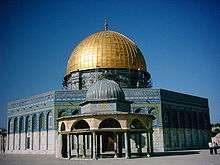
The second major event of the early reign of Abd al-Malik was the construction of the Dome of the Rock in Jerusalem. Although the chronology remains somewhat uncertain, the building seems to have been completed in 692, which means that it was under construction during the conflict with Ibn al-Zubayr. This had led some historians, both medieval and modern, to suggest that the Dome of the Rock was built as a destination for pilgrimage to rival the Kaaba, which was under the control of Ibn al-Zubayr.

Muslim state at the death of Muhammad Expansion under the Rashidun Caliphate Expansion under the Umayyad Caliphate
Abd al-Malik is credited with centralizing the administration of the Caliphate and with establishing Arabic as its official language. He also introduced a uniquely Muslim coinage, marked by its aniconic decoration, which supplanted the Byzantine and Sasanian coins that had previously been in use. Abd al-Malik also recommenced offensive warfare against Byzantium, defeating the Byzantines at Sebastopolis and recovering control over Armenia and Caucasian Iberia.
Caliph Abdul Malik also acquired many new lands under his reign. In the year 700 he sent an expedition to East Africa to add Mogadishu (located in present day Somalia) to the caliphate. The Muslim army was led by General Musa ibn Umar al-Khath'ami, the Syrian who not only expanded into Mogadishu and it's environs, but also Swahili island Kilwa. The objectives given to Musa ibn Umar were identical to those given to other Muslim commandors, to teach the Quran, secure the taxation or tribute, to protect and safeguard the security of the country and to affirm it's loyalty to the capital of the Umayyads in Damascus.[95][96]
Following Abd al-Malik's death, his son, Al-Walid I (705–715), became caliph. Al-Walid was also active as a builder, sponsoring the construction of Al-Masjid al-Nabawi in Medina and the Great Mosque of Damascus.
During the reign of al-Walid, the Umayyads conquered nearly the entirety of the Iberian Peninsula (except for the northernmost Christian kingdom of Asturias) under the military leadership of Tariq ibn Ziyad (whose name gives rise to 'Gibraltar' -- Jabal Tariq, or 'Mountain of Tariq') and Musa ibn Nusayr from 711-716 CE, decimating the preceding Visigothic Kingdom of Spain. In the year 712, Muhammad bin Qasim, an Umayyad general, sailed from the Persian Gulf into Sindh and conquered both Sindh and the lower Punjab (corresponding to Multan), both regions in northwestern India straddling the course of the Indus River. The conquest of Sindh and Punjab, in modern-day Pakistan, although costly, were major gains for the Umayyad Caliphate, yielding roughly 60 million dirhams according to the Arab historian al-Baladhuri (not including the taxes, levies and duties imposed on the rich trading outposts of Sindh on the Indian Ocean routes).[97] Finally, the commander Qutayba ibn Muslim conquered the wealthy and strategic Central Asian cities of Bukhara, Samarkand, Khwarezem and Farghana between 705 and 715 CE, annexing nearly the whole of Transoxiana north of the Iranian plateau and bordering the contemporary Tang dynasty of China. The conquests of Transoxiana, Sindh and Hispania accrued a massive amount of war spoils for the Caliphate, akin in value to the total value of the conquests achieved by the Rashidun caliph Umar ibn al-Khattab.[98] By this point, the Caliphate stretched from the Atlantic Ocean to the Indus River.
A major figure during the reigns of both al-Walid and Abd al-Malik was the Umayyad governor of Iraq, Al-Hajjaj bin Yousef. Many Iraqis remained resistant to Umayyad rule, and to maintain order al-Hajjaj imported Syrian troops, which he housed in a new garrison town, Wasit. These troops became crucial in the suppression of a revolt led by an Iraqi general, Ibn al-Ash'ath, in the early eighth century.
Al-Walid was succeeded by his brother, Sulayman (715–717), whose reign was dominated by a protracted siege of Constantinople. The failure of the siege marked the end of serious Arab ambitions against the Byzantine capital. However, the first two decades of the eighth century witnessed the continuing expansion of the Caliphate, which pushed into the Iberian Peninsula in the west, and into Transoxiana in the Muslim conquest of Transoxiana (under Qutayba ibn Muslim) and northern India in the east. Arab sources claim Qutayba ibn Muslim briefly took Kashgar from China and withdrew after an agreement[99] but modern historians entirely dismiss this claim.[100][101][102]
In AD 715, the Umayyad Caliphate deposed the ikhshid of the Principality of Farghana, and installed a new king Alutar on the throne. The deposed king fled to Kucha (seat of Anxi Protectorate), and sought Chinese intervention. The Tang dynasty sent 10,000 troops under Zhang Xiaosong to Ferghana. He defeated Alutar and the Arab occupation force at Namangan and reinstalled the ikhshid on the throne.[103] The Chinese defeated the Umayyad invaders at the Battle of Aksu (717), forcing the Umayyad commander, Al-Yashkuri, and his army to flee to Tashkent. The Umayyad were regarded as the Báiyī dà shí "The White-robed Tazi", (白衣大食) by the Tang Dynasty chronicles.[104][105]
Caliphate of Umar II
Sulayman was succeeded by his cousin, Umar ibn Abd al-Aziz (717–720), whose position among the Umayyad caliphs is somewhat unusual. He is the only Umayyad ruler to have been recognized by subsequent Islamic tradition as a genuine caliph (khalifa) and not merely as a worldly king (malik).
Umar is honoured for his attempt to resolve the fiscal problems attendant upon conversion to Islam. During the Umayyad period, the majority of people living within the caliphate were not Muslim, but Christian, Jewish, Zoroastrian, or members of other small groups. These religious communities were not forced to convert to Islam, but were subject to a tax (jizyah) which was not imposed upon Muslims. This situation may actually have made widespread conversion to Islam undesirable from the point of view of state revenue, and there are reports that provincial governors actively discouraged such conversions. It is not clear how Umar attempted to resolve this situation, but the sources portray him as having insisted on like treatment of Arab and non-Arab (mawali) Muslims, and on the removal of obstacles to the conversion of non-Arabs to Islam.
Later Marwanid period
After the death of Umar, another son of Abd al-Malik, Yazid II (720–724) became caliph. Yazid is best known for his "iconoclastic edict", which ordered the destruction of Christian images within the territory of the Caliphate. In 720, another major revolt arose in Iraq, this time led by Yazid ibn al-Muhallab.
Caliphate of Hisham and end of expansion
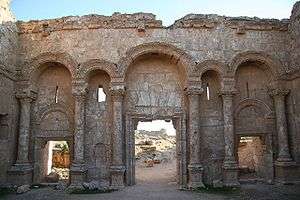
The final son of Abd al-Malik to become caliph was Hisham (724–43), whose long and eventful reign was above all marked by the curtailment of military expansion. Hisham established his court at Resafa in northern Syria, which was closer to the Byzantine border than Damascus, and resumed hostilities against the Byzantines, which had lapsed following the failure of the last siege of Constantinople. The new campaigns resulted in a number of successful raids into Anatolia, but also in a major defeat (the Battle of Akroinon), and did not lead to any significant territorial expansion.
From the caliphate's north-western African bases, a series of raids on coastal areas of the Visigothic Kingdom paved the way to the permanent occupation of most of Iberia by the Umayyads (starting in 711), and on into south-eastern Gaul (last stronghold at Narbonne in 759). Hisham's reign witnessed the end of expansion in the west, following the defeat of the Arab army by the Franks at the Battle of Tours in 732. In 739 a major Berber Revolt broke out in North Africa, which was probably the largest military setback in the reign of Caliph Hisham. From it, emerged some of the first Muslim states outside the Caliphate. It is also regarded as the beginning of Moroccan independence, as Morocco would never again come under the rule of an eastern Caliph or any other foreign power until the 20th century. It was followed by the collapse of Umayyad authority in al-Andalus. In India, the Umayyad armies were defeated by the south Indian Chalukya dynasty and by the north Indian Pratiharas Dynasty, stagnating further eastward Arab expansion.[106][107][108]
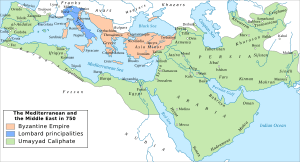
In the Caucasus, the confrontation with the Khazars peaked under Hisham: the Arabs established Derbent as a major military base and launched several invasions of the northern Caucasus, but failed to subdue the nomadic Khazars. The conflict was arduous and bloody, and the Arab army even suffered a major defeat at the Battle of Marj Ardabil in 730. Marwan ibn Muhammad, the future Marwan II, finally ended the war in 737 with a massive invasion that is reported to have reached as far as the Volga, but the Khazars remained unsubdued.
Hisham suffered still worse defeats in the east, where his armies attempted to subdue both Tokharistan, with its centre at Balkh, and Transoxiana, with its centre at Samarkand. Both areas had already been partially conquered, but remained difficult to govern. Once again, a particular difficulty concerned the question of the conversion of non-Arabs, especially the Sogdians of Transoxiana. Following the Umayyad defeat in the "Day of Thirst" in 724, Ashras ibn 'Abd Allah al-Sulami, governor of Khurasan, promised tax relief to those Sogdians who converted to Islam but went back on his offer when it proved too popular and threatened to reduce tax revenues.
Discontent among the Khorasani Arabs rose sharply after the losses suffered in the Battle of the Defile in 731. In 734, al-Harith ibn Surayj led a revolt that received broad backing from Arabs and natives alike, capturing Balkh but failing to take Merv. After this defeat, al-Harith's movement seems to have been dissolved. The problem of the rights of non-Arab Muslims would continue to plague the Umayyads.
Third Fitna
Hisham was succeeded by Al-Walid II (743–44), the son of Yazid II. Al-Walid is reported to have been more interested in earthly pleasures than in religion, a reputation that may be confirmed by the decoration of the so-called "desert palaces" (including Qusayr Amra and Khirbat al-Mafjar) that have been attributed to him. He quickly attracted the enmity of many, both by executing a number of those who had opposed his accession and by persecuting the Qadariyya.
In 744, Yazid III, a son of al-Walid I, was proclaimed caliph in Damascus, and his army tracked down and killed al-Walid II. Yazid III has received a certain reputation for piety and may have been sympathetic to the Qadariyya. He died a mere six months into his reign.
Yazid had appointed his brother, Ibrahim, as his successor, but Marwan II (744–50), the grandson of Marwan I, led an army from the northern frontier and entered Damascus in December 744, where he was proclaimed caliph. Marwan immediately moved the capital north to Harran, in present-day Turkey. A rebellion soon broke out in Syria, perhaps due to resentment over the relocation of the capital, and in 746 Marwan razed the walls of Homs and Damascus in retaliation.
Marwan also faced significant opposition from Kharijites in Iraq and Iran, who put forth first Dahhak ibn Qays and then Abu Dulaf as rival caliphs. In 747, Marwan managed to re-establish control of Iraq, but by this time a more serious threat had arisen in Khorasan.
Abbasid Revolution and fall
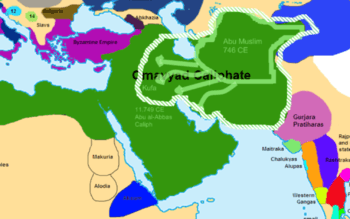
The Hashimiyya movement (a sub-sect of the Kaysanites Shia), led by the Abbasid family, overthrew the Umayyad caliphate. The Abbasids were members of the Hashim clan, rivals of the Umayyads, but the word "Hashimiyya" seems to refer specifically to Abu Hashim, a grandson of Ali and son of Muhammad ibn al-Hanafiyya. According to certain traditions, Abu Hashim died in 717 in Humeima in the house of Muhammad ibn Ali, the head of the Abbasid family, and before dying named Muhammad ibn Ali as his successor. This tradition allowed the Abbasids to rally the supporters of the failed revolt of Mukhtar, who had represented themselves as the supporters of Muhammad ibn al-Hanafiyya.
Beginning around 719, Hashimiyya missions began to seek adherents in Khurasan. Their campaign was framed as one of proselytism (dawah). They sought support for a "member of the family" of Muhammad, without making explicit mention of the Abbasids. These missions met with success both among Arabs and non-Arabs (mawali), although the latter may have played a particularly important role in the growth of the movement.
Around 746, Abu Muslim assumed leadership of the Hashimiyya in Khurasan. In 747, he successfully initiated an open revolt against Umayyad rule, which was carried out under the sign of the black flag. He soon established control of Khurasan, expelling its Umayyad governor, Nasr ibn Sayyar, and dispatched an army westwards. Kufa fell to the Hashimiyya in 749, the last Umayyad stronghold in Iraq, Wasit, was placed under siege, and in November of the same year Abul Abbas as-Saffah was recognized as the new caliph in the mosque at Kufa. At this point Marwan mobilized his troops from Harran and advanced toward Iraq. In January 750 the two forces met in the Battle of the Zab, and the Umayyads were defeated. Damascus fell to the Abbasids in April, and in August, Marwan was killed in Egypt.
The victors desecrated the tombs of the Umayyads in Syria, sparing only that of Umar II, and most of the remaining members of the Umayyad family were tracked down and killed. When Abbasids declared amnesty for members of the Umayyad family, eighty gathered to receive pardons, and all were massacred. One grandson of Hisham, Abd al-Rahman I, survived, escaped across North Africa, and established an emirate in Moorish Iberia (Al-Andalus). In a claim unrecognized outside of al-Andalus, he maintained that the Umayyad Caliphate, the true, authentic caliphate, more legitimate than the Abbasids, was continued through him in Córdoba. It was to survive for centuries.
Previté-Orton argues that the reason for the decline of the Umayyads was the rapid expansion of Islam. During the Umayyad period, mass conversions brought Persians, Berbers, Copts, and Aramaics to Islam. These mawalis (clients) were often better educated and more civilised than their Arab overlords. The new converts, on the basis of equality of all Muslims, transformed the political landscape. Previté-Orton also argues that the feud between Syria and Iraq further weakened the empire.[109]
Umayyad administration
The first four caliphs created a stable administration for the empire, following the practices and administrative institutions of the Byzantine Empire which had ruled the same region previously.[110] These consisted of four main governmental branches: political affairs, military affairs, tax collection, and religious administration. Each of these was further subdivided into more branches, offices, and departments.
Provinces
Geographically, the empire was divided into several provinces, the borders of which changed numerous times during the Umayyad reign. Each province had a governor appointed by the caliph. The governor was in charge of the religious officials, army leaders, police, and civil administrators in his province. Local expenses were paid for by taxes coming from that province, with the remainder each year being sent to the central government in Damascus. As the central power of the Umayyad rulers waned in the later years of the dynasty, some governors neglected to send the extra tax revenue to Damascus and created great personal fortunes.[111]
Government workers
As the empire grew, the number of qualified Arab workers was too small to keep up with the rapid expansion of the empire. Therefore, Muawiya allowed many of the local government workers in conquered provinces to keep their jobs under the new Umayyad government. Thus, much of the local government's work was recorded in Greek, Coptic, and Persian. It was only during the reign of Abd al-Malik that government work began to be regularly recorded in Arabic.[111]
Currency
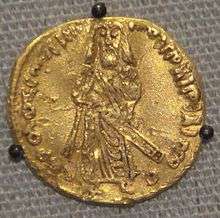

The Byzantine and Sassanid Empires relied on money economies before the Muslim conquest, and that system remained in effect during the Umayyad period. Byzantine copper coins were used until 658, while Byzantine gold coins were still in use until the monetary reforms c.700.[112] In addition to this, the Umayyad government began to mint its own coins in Damascus, which were initially similar to pre-existing coins but evolved in an independent direction. These were the first coins minted by a Muslim government in history. Gold coins were called dinars while silver coins were called dirhams.[111]
Central diwans
To assist the Caliph in administration there were six Boards at the Centre: Diwan al-Kharaj (the Board of Revenue), Diwan al-Rasa'il (the Board of Correspondence), Diwan al-Khatam (the Board of Signet), Diwan al-Barid (the Board of Posts), Diwan al-Qudat (the Board of Justice) and Diwan al-Jund (the Military Board)
Diwan al-Kharaj
The Central Board of Revenue administered the entire finances of the empire. It also imposed and collected taxes and disbursed revenue.
Diwan al-Rasa'il
A regular Board of Correspondence was established under the Umayyads. It issued state missives and circulars to the Central and Provincial Officers. It co-ordinated the work of all Boards and dealt with all correspondence as the chief secretariat.
Diwan al-Khatam
In order to reduce forgery, Diwan al-Khatam (Bureau of Registry), a kind of state chancellery, was instituted by Mu'awiyah. It used to make and preserve a copy of each official document before sealing and despatching the original to its destination. Thus in the course of time a state archive developed in Damascus by the Umayyads under Abd al-Malik. This department survived till the middle of the Abbasid period.
Diwan al-Barid
Mu'awiyah introduced postal service, Abd al-Malik extended it throughout his empire, and Walid made full use of it. Umar bin Abdul-Aziz developed it further by building caravanserais at stages along the Khurasan highway. Relays of horses were used for the conveyance of dispatches between the caliph and his agents and officials posted in the provinces. The main highways were divided into stages of 12 miles (19 km) each and each stage had horses, donkeys or camels ready to carry the post. Primarily the service met the needs of Government officials, but travellers and their important dispatches were also benefited by the system. The postal carriages were also used for the swift transport of troops. They were able to carry fifty to a hundred men at a time. Under Governor Yusuf bin Umar, the postal department of Iraq cost 4,000,000 dirhams a year.
Diwan al-Qudat
In the early period of Islam, justice was administered by Muhammad and the orthodox Caliphs in person. After the expansion of the Islamic State, Umar al-Faruq had to separate judiciary from the general administration and appointed the first qadi in Egypt as early as AD 643/23 AH. After 661, a series of judges served in Egypt during the caliphates of Hisham and Walid II.
Diwan al-Jund
The Diwan of Umar, assigning annuities to all Arabs and to the Muslim soldiers of other races, underwent a change in the hands of the Umayyads. The Umayyads meddled with the register and the recipients regarded pensions as the subsistence allowance even without being in active service. Hisham reformed it and paid only to those who participated in battle. On the pattern of the Byzantine system the Umayyads reformed their army organization in general and divided it into five corps: the centre, two wings, vanguards and rearguards, following the same formation while on march or on a battle field. Marwan II (740–50) abandoned the old division and introduced the Kurdus (cohort), a small compact body. The Umayyad troops were divided into three divisions: infantry, cavalry and artillery. Arab troops were dressed and armed in Greek fashion. The Umayyad cavalry used plain and round saddles. The artillery used the arradah (ballista), the manjaniq (mangonel) and the dabbabah or kabsh (battering ram). The heavy engines, siege machines and baggage were carried on camels behind the army.
Social organization
The Umayyad Caliphate had four main social classes:
- Muslim Arabs
- Muslim non-Arabs (clients of the Muslim Arabs)
- Dhimmis (non-Muslim free persons such as Christians, Jews and Zoroastrians)
- Slaves
The Muslim Arabs were at the top of the society and saw it as their duty to rule over the conquered areas. Despite the fact that Islam teaches the equality of all Muslims, the Arab Muslims held themselves in higher esteem than Muslim non-Arabs and generally did not mix with other Muslims.
As Islam spread, more and more of the Muslim population consisted of non-Arabs. This caused social unrest, as the new converts were not given the same rights as Muslim Arabs. Also, as conversions increased, tax revenues from non-Muslims decreased to dangerous lows. These issues continued to worsen until they helped cause the Abbasid Revolt in the 740s.[114]
Non-Muslims
Non-Muslim groups in the Umayyad Caliphate, which included Christians, Jews, Zoroastrians and pagans, were called dhimmis. They were given a legally protected status as second-class citizens as long as they accepted and acknowledged the political supremacy of the ruling Muslims, i.e. paid a tax, known as jizya, which the Muslims did not have to pay, who would instead pay the zakat tax. If they converted to Islam they would cease paying jizya and would instead pay zakat.
Although the Umayyad's were harsh when it came to defeating their Zoroastrian adversaries,[115] but they did, however, offer protection and relative religious tolerance to the Zoroastrians who accepted their authority.[116] As a matter of fact, Umar II was reported to have said in one of his letters commanding not to "destroy a synagogue or a church or temple of fire worshippers(meaning the zoroastrians) as long as they have reconciled with and agreed upon with the Muslims".[117] Fred Donner says that Zoroastrians in the northern parts of Iran were hardly penetrated by the "believers" winning virtually complete autonomy in-return for tribute-tax or jizyah.[118] Donner adds "Zoroastrians continued to exist in large numbers in northern and western Iran and elsewhere for centuries after the rise of Islam, and indeed, much of the canon of Zoroastrian religious texts was elaborated and written down during the Islamic period."[119]
Christians and Jews still continued to produce great theological thinkers within their communities, but as time wore on, many of the intellectuals converted to Islam, leading to a lack of great thinkers in the non-Muslim communities.[120] Important Christian writers from the Umayyad period include the theologian John of Damascus, bishop Cosmas of Maiuma, Pope Benjamin I of Alexandria and Isaac of Nineveh.[121]
Although non-Muslims could not hold the highest public offices in the empire, they held many bureaucratic positions within the government. An important example of Christian employment in the Umayyad government is that of Sarjun ibn Mansur. He was a Melkite Christian official of the early Umayyad Caliphate. The son of a prominent Byzantine official of Damascus, he was a favourite of the early Umayyad caliphs Mu'awiya I and Yazid I, and served as the head of the fiscal administration for Syria from the mid-7th century until the year 700, when Caliph Abd al-Malik ibn Marwan dismissed him as part of his efforts to Arabicize the administration of the Caliphate. According to the Muslim historians al-Baladhuri and al-Tabari, Sanjur was a mawla of the first Umayyad caliph, Mu'awiya I (r. 661–680),[lower-alpha 1] serving as his "secretary and the person in charge of his business".[121][123] The hagiographies, although less reliable, also assign to him a role in the administration, even as "ruler" (archon or even amir), of Damascus and its environs, where he was responsible for collecting the revenue.[121] In this capacity, he is attested in later collections of source material such as that of al-Mas'udi.[122] Sarjun ibn Mansur was replaced by Sulayman ibn Sa'd al-Khushani, another Christian.[124]
Muawiya's marriage to Maysun bint Bahdal (Yazid's mother) was politically motivated, as she was the daughter of the chief of the Kalb tribe, which was a large Syriac Orthodox Christian Arab tribe in Syria.[125] The Kalb tribe had remained largely neutral when the Muslims first went into Syria.[126] After the plague that killed much of the Muslim army in Syria, by marrying Maysun, Muawiyah used the Syriac Orthodox Christians against the Byzantines.
Tom Holland writes [127] Christians, Jews, Samaritans and Manichaeans were all treated well by Muawiyah. Muawiyah even restored Edessa's cathedral after it had been toppled by an earthquake.[128] Savagely though Muawiyah prosecuted his wars against the Romans, yet his subjects, no longer trampled by rival armies, no longer divided by hostile watchtowers, knew only peace at last. Justice flourished in his time, and there was great peace in the regions under his control. He allowed everyone to live as they wanted."[127][129]
Legacy
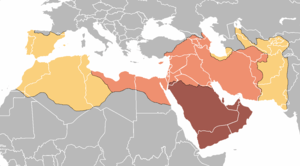
Muawiyah I's family, including his progenitors, Abu Sufyan ibn Harb and his wife Hind bint Utbah, were originally opponents of Islam and particularly of Muhammad until the Conquest of Mecca, but they converted to the religion in 630. However, many early history books, e.g., The Islamic Conquest of Syria Fatuhusham, by al-Imam al-Waqidi, state that, after their conversion to Islam, Muhammad appointed Muawiyah I's father Abu Sufyan ibn Harb and his brother Yazid ibn Abi Sufyan as army commanders. Muawiyah I, Abu Sufyan ibn Harb, Yazid ibn Abi Sufyan and Hind bint Utbah[130][131][131][132][133][134] fought in the Battle of Yarmouk. The defeat of the Byzantine Emperor Heraclius at the Battle of Yarmouk opened the way for Muslim expansion into Jerusalem and Syria.
In 639, Muawiyah was appointed as the governor of Syria by the second caliph, Umar, after the two previous governors—his brother Yazid ibn Abi Sufyan and, before him, Abu Ubaidah ibn al-Jarrah—died in a plague along with 25,000 other people.[135][136] 'Amr ibn al-'As was sent to take on the Roman Army in Egypt. Umar asked Muawiyah to defend against an anticipated Roman attack. Muawiyah next set about creating allies. Muawiyah married Maysum, the daughter of the chief of the Kalb tribe, a large Jacobite Christian Arab tribe in Syria. His marriage to Maysum was politically motivated. The Kalb tribe had remained largely neutral when the Muslims first went into Syria.[126] Muawiyah now could use the Jacobite Christians to restore the ranks of the plague-depleted army against the Romans. Muawiya's wife Maysum (Yazid's mother) was also a Jacobite Christian.[125] With limited resources and the Byzantines just over the border, Muawiyah worked in cooperation with the local Christian population. To stop Byzantine harassment from the sea during the Arab-Byzantine Wars, in 649 Muawiyah set up a navy, which was manned by Monophysite Christians, Copts, and Jacobite Syrian Christian sailors and Muslim troops.[137][138]
Muawiya was one of the first to realize the full importance of having a navy; as long as the Byzantine fleet could sail the Mediterranean unopposed, the coastlines of Syria, Palestine and Egypt would never be safe. Muawiyah, along with Adbullah ibn Sa'd, the new governor of Egypt, successfully persuaded Uthman to give them permission to construct a large fleet in the dockyards of Egypt and Syria.[137][138] The first real naval engagement between the Muslim and the Byzantine navy was the so-called Battle of the Masts (Dhat al-sawari), or Battle of Phoenix, off the Lycian coast in 655,[139] where the resulting Muslim victory opened up the Mediterranean.[137][138][140][141][142][143][144] Muawiyah I came to power after the death of Ali and established a dynasty.
Historical significance
| History of the Levant |
|---|
| Stone Age |
| Ancient history |
| Classical antiquity |
|
| Middle Ages |
| Modern history |
|
The Umayyad caliphate was marked both by territorial expansion and by the administrative and cultural problems that such expansion created. Despite some notable exceptions, the Umayyads tended to favor the rights of the old Arab families, and in particular their own, over those of newly converted Muslims (mawali). Therefore, they held to a less universalist conception of Islam than did many of their rivals. As G.R. Hawting has written, "Islam was in fact regarded as the property of the conquering aristocracy."[145]
During the period of the Umayyads, Arabic became the administrative language and the process of Arabization was initiated in the Levant, Mesopotamia, North Africa and Iberia. State documents and currency were issued in the Arabic. Mass conversions also created a growing population of Muslims in the territory of the Caliphate.
According to one common view, the Umayyads transformed the caliphate from a religious institution (during the Rashidun caliphate) to a dynastic one.[146] However, the Umayyad caliphs do seem to have understood themselves as the representatives of God on earth, and to have been responsible for the "definition and elaboration of God's ordinances, or in other words the definition or elaboration of Islamic law."[147]
The Umayyads have met with a largely negative reception from later Islamic historians, who have accused them of promoting a kingship (mulk, a term with connotations of tyranny) instead of a true caliphate (khilafa). In this respect it is notable that the Umayyad caliphs referred to themselves not as khalifat rasul Allah ("successor of the messenger of God", the title preferred by the tradition), but rather as khalifat Allah ("deputy of God"). The distinction seems to indicate that the Umayyads "regarded themselves as God's representatives at the head of the community and saw no need to share their religious power with, or delegate it to, the emergent class of religious scholars."[148] In fact, it was precisely this class of scholars, based largely in Iraq, that was responsible for collecting and recording the traditions that form the primary source material for the history of the Umayyad period. In reconstructing this history, therefore, it is necessary to rely mainly on sources, such as the histories of Tabari and Baladhuri, that were written in the Abbasid court at Baghdad.
Modern Arab nationalism regards the period of the Umayyads as part of the Arab Golden Age which it sought to emulate and restore. This is particularly true of Syrian nationalists and the present-day state of Syria, centered like that of the Umayyads on Damascus. The Umayyad dynastic color was white, after the banner of Muawiya ibn Abi Sufyan;[149] it is now one of the four Pan-Arab colours which appear in various combinations on the flags of most Arab countries.
Architecture
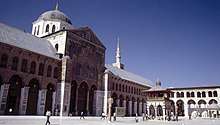
Throughout the Levant, Egypt and North Africa, the Umayyads constructed grand congregational mosques and desert palaces, as well as various garrison cities (amsar) to fortify their frontiers such as Fustat, Kairouan, Kufa, Basra and Mansura. Many of these buildings feature Byzantine stylistic and architectural features, such as Roman mosaics and Corinthian columns. Their most famous constructions include the Dome of the Rock at Jerusalem and the Umayyad Mosque at Damascus,[146] and other constructions include Hisham's Palace, Qusayr' Amra, the Great Mosque of Kairouan and the Great Mosque of Aleppo. Some of these buildings, such as the Umayyad Mosque of Damascus, reflect the diversity of the empire, as thousands of Greek, Persian, Coptic, Indian and Persian craftsmen were conscripted to construct them. The later Emirate of Cordoba (an offshoot of the Umayyad dynasty in exile) established many endearing architectural projects in the Iberian Peninsula such as the Mosque-Cathedral of Cordoba and Medina Azahara, which influenced the architectural styles during the Middle Ages.
Theological view of the Umayyads
Sunni
Many Muslims criticized the Umayyads for having too many non-Muslim, former Roman administrators in their government, e.g., St. John of Damascus.[150] As the Muslims took over cities, they left the people's political representatives, the Roman tax collectors, and the administrators in office. The taxes to the central government were calculated and negotiated by the people's political representatives. Both the central and local governments were compensated for the services each provided. Many Christian cities used some of the taxes to maintain their churches and run their own organizations. Later, the Umayyads were criticized by some Muslims for not reducing the taxes of the people who converted to Islam.[151]
Later, when Umar ibn Abd al-Aziz came to power, he reduced these taxes. He is therefore praised as one of the greatest Muslim rulers after the four Rightly Guided Caliphs. Imam Abu Muhammad Adbullah ibn Abdul Hakam who lived in 829 and wrote a biography on Umar Ibn Adbul Aziz[152] stated that the reduction in these taxes stimulated the economy and created wealth but it also reduced the government's budget, including, eventually, the defence budget.
The only Umayyad ruler, who is unanimously praised by Sunni sources for his devout piety and justice is Umar ibn Abd al-Aziz. In his efforts to spread Islam, he established liberties for the Mawali by abolishing the jizya tax for converts to Islam. Imam Abu Muhammad Adbullah ibn Abdul Hakam stated that Umar ibn Abd al-Aziz also stopped the personal allowance offered to his relatives, stating that he could only give them an allowance if he gave an allowance to everyone else in the empire. After Umar ibn Abd al-Aziz was poisoned in 720, successive governments tried to reverse Umar ibn Abd al-Aziz's tax policies, but rebellion resulted.
Shi'a
The negative view of the Umayyads held by Shias is briefly expressed in the Shi'a book "Sulh al-Hasan".[153] According to Shia hadiths, which are not considered authentic by Sunnis, Ali described them as the worst Fitna.[154] In Shia sources, the Umayyad Caliphate is widely described as "tyrannical, anti-Islamic and godless".[155] Shias point out that the founder of the dynasty, Muawiyah, declared himself a caliph in 657 and went to war against Muhammad's son-in-law and cousin, the ruling caliph Ali, clashing at the Battle of Siffin. Muawiyah also declared his son, Yazid, as his successor in breach of a treaty with Hassan, Muhammad's grandson. Another of Muhammad's grandsons, Husayn ibn Ali, would be killed by Yazid in the Battle of Karbala. Further Shia Imams, such as Muhammad's great-grandson, Ali ibn Husayn Zayn al-Abidin would be killed at the hands of ruling Umayyad caliphs.
Bahá'í
Asked for an explanation of the prophecies in the Book of Revelation (12:3), `Abdu'l-Bahá suggests in Some Answered Questions that the "great red dragon, having seven heads and ten horns, and seven crowns upon his heads,"[156] refers to the Umayyad caliphs who "rose against the religion of Prophet Muhammad and against the reality of Ali".[157][158]
The seven heads of the dragon are symbolic of the seven provinces of the lands dominated by the Umayyads: Damascus, Persia, Arabia, Egypt, Africa, Andalusia, and Transoxiana. The ten horns represent the ten names of the leaders of the Umayyad dynasty: Abu Sufyan, Muawiya, Yazid, Marwan, Abd al-Malik, Walid, Sulayman, Umar, Hisham, and Ibrahim. Some names were re-used, as in the case of Yazid II and Yazid III, which were not accounted for in this interpretation.
Early literature
The book Al Muwatta, by Imam Malik, was written in the early Abbasid period in Medina. It does not contain any anti-Umayyad content because it was more concerned with what the Quran and what Muhammad said and was not a history book on the Umayyads.
Even the earliest pro-Shia accounts of al-Masudi are more balanced. Al-Masudi's Ibn Hisham is the earliest Shia account of Muawiyah. He recounted that Muawiyah spent a great deal of time in prayer, in spite of the burden of managing a large empire.[159]
Az-Zuhri stated that Muawiya led the Hajj Pilgrimage with the people twice during his era as caliph.
Books written in the early Abbasid period like al-Baladhuri's "The Origins of the Islamic State" provide a more accurate and balanced history. Ibn Hisham also wrote about these events.
Much of the anti-Umayyad literature started to appear in the later Abbasid period in Persia.
After killing off most of the Umayyads and destroying the graves of the Umayyad rulers apart from Muawiyah and Umar ibn Adb al-Aziz, the history books written during the later Abbasid period are more anti-Umayyad.[160] The Abbasids justified their rule by saying that their ancestor Abbas ibn Abd al-Muttalib was a cousin of Muhammad.
The books written later in the Abbasid period in Iran are more anti-Umayyad. Iran was Sunni at the time. There was much anti-Arab feeling in Iran after the fall of the Persian empire.[161] This anti-Arab feeling also influenced the books on Islamic history. Al-Tabri was also written in Iran during that period. Al-Tabri was a huge collection, preserving everything the compiler could find for future generations to codify and to judge whether the histories were true or false.
List of Caliphs
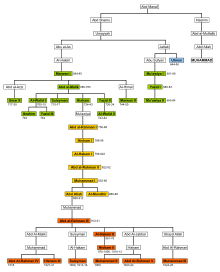
| Caliph | Reign |
|---|---|
| Caliphs of Damascus | |
| Muawiya I ibn Abu Sufyan | 28 July 661 – 27 April 680 |
| Yazid I ibn Muawiyah | 27 April 680 – 11 November 683 |
| Muawiya II ibn Yazid | 11 November 683– June 684 |
| Marwan I ibn al-Hakam | June 684– 12 April 685 |
| Abd al-Malik ibn Marwan | 12 April 685 – 8 October 705 |
| al-Walid I ibn Abd al-Malik | 8 October 705 – 23 February 715 |
| Sulayman ibn Abd al-Malik | 23 February 715 – 22 September 717 |
| Umar ibn Abd al-Aziz | 22 September 717 – 4 February 720 |
| Yazid II ibn Abd al-Malik | 4 February 720 – 26 January 724 |
| Hisham ibn Abd al-Malik | 26 January 724 – 6 February 743 |
| al-Walid II ibn Yazid | 6 February 743 – 17 April 744 |
| Yazid III ibn al-Walid | 17 April 744 – 4 October 744 |
| Ibrahim ibn al-Walid | 4 October 744 – 4 December 744 |
| Marwan II ibn Muhammad (ruled from Harran in the Jazira) | 4 December 744 – 25 January 750 |
See also
Notes
- Mu'awiya I was generally favourably disposed towards Christians and, according to al-Ya'qubi, the first Muslim caliph to employ Christians in administrative positions.[122]
References
- Rein Taagepera (September 1997). "Expansion and Contraction Patterns of Large Polities: Context for Russia". International Studies Quarterly. 41 (3): 496. doi:10.1111/0020-8833.00053. JSTOR 2600793.
- "Umayyad". Collins English Dictionary. HarperCollins. Retrieved 12 May 2019.
- "Umayyad". The American Heritage Dictionary of the English Language (5th ed.). Boston: Houghton Mifflin Harcourt. Retrieved 12 May 2019.
- "Umayyad" (US) and {{Cite Oxford Dictionaries|Umayyad|accessdate=12 May 2019}}
- "Umayyad". Merriam-Webster Dictionary. Retrieved 12 May 2019.
- "Umayyad dynasty". Britannica. Retrieved 19 May 2016.
- Bukhari, Sahih. "Sahih Bukhari: Read, Study, Search Online".
- Simon Barton (30 June 2009). A History of Spain. Macmillan International Higher Education. pp. 44–5. ISBN 978-1-137-01347-7.
- Francis Preston Venable (1894). A Short History of Chemistry. Heath. p. 21.
- H.U. Rahman, A Chronology Of Islamic History 570–1000 CE (1999), p. 128.
- "Islamic Economics". www.hetwebsite.net.
- Cavendish, Marshall (1 September 2006). World and Its Peoples. Marshall Cavendish. ISBN 9780761475712 – via Google Books.
- Haag, Michael (1 November 2012). The Tragedy of the Templars: The Rise and Fall of the Crusader States. Profile Books. ISBN 9781847658548 – via Google Books.
- Levi Della Vida & Bosworth 2000, p. 838.
- Donner 1981, p. 51.
- Hawting 2000, pp. 22–23.
- Wellhausen 1927, pp. 40–41.
- Hawting 2000, p. 23.
- Donner 1981, p. 77.
- Wellhausen 1927, p. 20.
- Wellhausen 1927, pp. 20–21.
- Kennedy 2004, p. 50.
- Kennedy 2004, p. 51.
- Kennedy 2004, pp. 51–52.
- Kennedy 2004, pp. 51–53.
- Madelung 1997, p. 45.
- Donner 1981, p. 114.
- Madelung 1997, pp. 60–61.
- Madelung 1997, p. 61.
- Kennedy 2004, pp. 62–64.
- Madelung 1997, p. 80.
- Wellhausen 1927, p. 45.
- Kennedy 2004, p. 70.
- Kennedy 2004, p. 75.
- Kennedy 2004, p. 63.
- Madelung 1997, pp. 80–81.
- Madelung 1997, p. 81.
- Madelung 1997, p. 141.
- Kennedy 2004, pp. 75–76.
- Hawting 2000, p. 27.
- Kennedy 2004, p. 76.
- Wellhausen 1927, p. 53.
- Kennedy 2004, pp. 76, 78.
- Wellhausen 1927, pp. 55–56.
- Madelung 1997, p. 190.
- Hinds 1993, p. 265.
- Kennedy 2004, p. 79.
- Kennedy 2004, p. 80.
- Hinds 1993, p. 59.
- Wellhausen 1927, p. 59.
- Wellhausen 1927, pp. 59–60.
- Hawting 2000, p. 842.
- Wellhausen 1927, p. 55.
- Kennedy 2004, pp. 86–87.
- Kaegi 1992, p. 247.
- Kennedy 2004, pp. 87–88.
- Lilie 1976, pp. 81–82.
- Kennedy 2004, p. 82.
- Kennedy 2004, pp. 82–83.
- Kennedy 2004, p. 83.
- Kennedy 2004, pp. 83–85.
- Kennedy 2004, p. 85.
- Kennedy 2004, p. 86.
- Kennedy 2004, p. 87.
- Kennedy 2007, p. 209.
- Christides 2000, p. 790.
- Wellhausen 1927, p. 135.
- Duri 2011, pp. 22–23.
- Kennedy 2004, p. 88.
- Kennedy 2004, pp. 88–89.
- Kennedy 2004, p. 89.
- Kennedy 2004, pp. 89–90.
- Kennedy 2004, p. 90.
- Gibb 1960, p. 55.
- Bosworth 1993, p. 268.
- Duri 2011, pp. 23–24.
- Levi Della Vida & Bosworth 2000, pp. 838–839.
- Kennedy 2004, p. 91.
- Duri 2011, pp. 24–25.
- Kennedy 2004, pp. 90–91.
- Crone 1994, p. 45.
- Crone 1994, p. 46.
- Wellhausen 1927, pp. 201–202.
- Kennedy 2001, p. 33.
- Wellhausen 1927, p. 182.
- Kennedy 2004, pp. 92–93.
- Kennedy 2004, p. 92.
- Kennedy 2004, p. 93.
- Kennedy 2001, pp. 32–33.
- Dixon 1969, pp. 220–222.
- Kennedy 2004, pp. 97–98.
- Dixon 1969, pp. 174–176, 206–208.
- Dixon 1969, pp. 235–239.
- Kennedy 2004, p. 98.
- Ahmed, Ali Jimale (1995). The Invention of Somalia. The Red Sea Press. ISBN 978-0-932415-99-8.
- Mukhtar, Mohamed Haji (25 February 2003). Historical Dictionary of Somalia. Scarecrow Press. ISBN 978-0-8108-6604-1.
- Banaji, J. (1 January 2010), "Chapter Nine. Islam, The Mediterranean And The Rise Of Capitalism", Theory as History, BRILL, ISBN 978-90-04-18372-8, retrieved 28 March 2020
- Blankinship, Khalid Yahya; Blankinship, Khalid 'A (1 January 1994). The End of the Jihad State: The Reign of Hisham Ibn 'Abd al-Malik and the Collapse of the Umayyads. SUNY Press. ISBN 978-0-7914-1827-7.
- Muhamad S. Olimat (27 August 2015). China and Central Asia in the Post-Soviet Era: A Bilateral Approach. Lexington Books. pp. 10–. ISBN 978-1-4985-1805-5.
- Litvinsky, B. A.; Jalilov, A. H.; Kolesnikov, A. I. (1996). "The Arab Conquest". In Litvinsky, B. A. (ed.). History of civilizations of Central Asia, Volume III: The crossroads of civilizations: A.D. 250 to 750. Paris: UNESCO Publishing. pp. 449–472. ISBN 978-92-3-103211-0.
- Bosworth, C. E. (1986). "Ḳutayba b. Muslim". In Bosworth, C. E.; van Donzel, E.; Lewis, B. & Pellat, Ch. (eds.). The Encyclopaedia of Islam, New Edition, Volume V: Khe–Mahi. Leiden: E. J. Brill. pp. 541–542. ISBN 90-04-07819-3.
- Gibb, H. A. R. (1923). The Arab Conquests in Central Asia. London: The Royal Asiatic Society. pp. 48–51. OCLC 685253133.
-
- Bai, Shouyi et al. (2003). A History of Chinese Muslim (Vol.2). Beijing: Zhonghua Book Company. ISBN 7-101-02890-X., pp. 235–236
- Christopher I. Beckwith (28 March 1993). The Tibetan Empire in Central Asia: A History of the Struggle for Great Power Among Tibetans, Turks, Arabs, and Chinese During the Early Middle Ages. Princeton University Press. pp. 88–89. ISBN 978-0-691-02469-1.
- Insight Guides (1 April 2017). Insight Guides Silk Road. APA. ISBN 978-1-78671-699-6.
- The Cambridge Shorter History of India p.131-132
- Early India: From the Origins to A.D. 1300 by Romila Thapar p.333
- An Atlas and Survey of South Asian History by Karl J. Schmidt p.34
- Previté-Orton (1971), vol. 1, pg. 239
- Neal Robinson, Islam: A Concise Introduction, (RoutledgeCurzon, 1999), 22.
- Ochsenwald, William (2004). The Middle East, A History. McGraw Hill. p. 57. ISBN 978-0-07-244233-5.
- The Mining, Minting, and Acquisition of Gold in the Roman and Post-Roman World, Fernando Lopez Sanchez, Ownership and Exploitation of Land and Natural Resources in the Roman World, ed. Paul Erdkamp, Koenraad Verboven, and Arjan Zuiderhoek, (Oxford University Press, 2015), 324.
- R.M. Foote et al., Report on Humeima excavations, in V. Egan and P.M. Bikai, "Archaeology in Jordan", American Journal of Archaeology 103 (1999), p. 514.
- Ochsenwald, William (2004). The Middle East, A History. McGraw Hill. pp. 55–56. ISBN 978-0-07-244233-5.
- Marietta Stepaniants, Philosophy East and West Vol. 52, No. 2 (Apr., 2002), pp. 163
- ibid
- Recorded by Ibn Abu Shayba in Al-Musanaf and Abu 'Ubaid Ibn Sallam in his book Al-Amwal, pp.123
- Fred M Donner, Muhammad and the Believers: At the Origins of Islam,(May 2010), pp. 110-111
- ibid
- Ochsenwald, William (2004). The Middle East, A History. McGraw Hill. p. 56. ISBN 978-0-07-244233-5.
- PmbZ, Sarğūn ibn Manṣūr ar-Rūmī (#6510).
- Griffith 2016, p. 31.
- Morony 1996, p. 216.
- Sprengling 1939, p. 213.
- A Chronology Of Islamic History 570–1000 CE, By H.U. Rahman 1999 Page 72
- Encyclopedia of Islam Volume VII, page 265, By Bosworth
- Holland 2013, p. 402.
- Holland 2013, p. 406.
- John bar Penkaye page 61.
- Islamic Conquest of Syria A translation of Fatuhusham by al-Imam al-Waqidi Translated by Mawlana Sulayman al-Kindi, page 325 Archived 12 October 2013 at the Wayback Machine
- al-Baladhuri 892 [19] Medieval Sourcebook: Al-Baladhuri: The Battle Of The Yarmuk (636) Archived 11 October 2013 at the Wayback Machine
- Islamic Conquest of Syria A translation of Fatuhusham by al-Imam al-Waqidi Translated by Mawlana Sulayman al-Kindi, page 331 to 334 Archived 12 October 2013 at the Wayback Machine
- Islamic Conquest of Syria A translation of Fatuhusham by al-Imam al-Waqidi Translated by Mawlana Sulayman al-Kindi, page 343-344 Archived 12 October 2013 at the Wayback Machine
- Al-Baladhuri from The Origins of the Islamic State, being a translation from the Arabic of the Kitab Futuh al-Buldha of Ahmad ibn-Jabir al-Baladhuri, trans. by P. K. Hitti and F. C. Murgotten, Studies in History, Economics and Public Law, LXVIII (New York, Columbia University Press, 1916 and 1924), I, 207–211
- Madelung, Wilferd (1998). The Succession to Muhammad A Study of the Early Caliphate. Cambridge University Press. ISBN 978-0-521-64696-3.
- A Chronology Of Islamic History 570-1000 CE, By H.U. Rahman 1999 Page 40
- A Chronology Of Islamic History 570–1000 CE, By H.U. Rahman 1999 Page 48-49
- The Great Arab Conquests By Hugh Kennedy, page 326
- The Great Arab Conquests By Hugh Kennedy, page 327
- Lewis, Archibald Ross (1985). European Naval and Maritime History, 300–1500. Indiana University Press. p. 24. ISBN 978-0-253-32082-7.
- Kroll, Leonard Michael (2005). History of the Jihad Islam Versus Civilization. AuthorHouse. p. 123. ISBN 978-1-4634-5730-3.
- Gregory, Timothy E. (2011). A History of Byzantium. John Wiley & Sons. p. 183. ISBN 978-1-4443-5997-8.
- Weston, Mark (2008). Prophets and Princes Saudi Arabia from Muhammad to the Present. John Wiley & Sons. p. 61. ISBN 978-0-470-18257-4.
- Bradbury, Jim (1992). The Medieval Siege. Boydell & Brewer. p. 11. ISBN 978-0-85115-357-5.
- G.R. Hawting, The first dynasty of Islam: the Umayyad caliphate, AD 661–750 (London, 2000), 4.
- Previté-Orton (1971), pg 236
- P. Crone and M. Hinds, God's caliph: religious authority in the first centuries of Islam (Cambridge, 1986), p. 43.
- G.R. Hawting, The first dynasty of Islam: the Umayyad caliphate, AD 661–750 (London, 2000), 13.
- Hathaway, Jane (2012). A Tale of Two Factions: Myth, Memory, and Identity in Ottoman Egypt and Yemen. SUNY Press. p. 97. ISBN 9780791486108.
- Choueiri, Youssef M. (15 April 2008). A Companion to the History of the Middle East. John Wiley & Sons. ISBN 9781405152044 – via Google Books.
- "Student Resources, Chapter 12: The First Global Civilization: The Rise and Spread of Islam, IV. The Arab Empire of the Umayyads, G. Converts and 'People of the Book'". occawlonline.pearsoned.com. Archived from the original on 21 May 2002.
- Umar Ibn Adbul Aziz By Imam Abu Muhammad Adbullah ibn Abdul Hakam died 214 AH 829 C.E. Publisher Zam Zam Publishers Karachi
- Shaykh Radi Aal-yasin (2000). "Mu'awiya And The Shi'a Of 'Ali, Peace Be On Him". Sulh Al-Hasan. Ansariyan Publishers. pp. 297–344. ISBN 978-1-4960-4085-5. Archived from the original on 20 January 2004.
- "Sermon 92: About the annihilation of the Kharijites, the mischief mongering of Umayyads and the vastness of his own knowledge". nahjulbalagha.org. Archived from the original on 19 August 2007.
- Sharon, Moshe (1983). Black Banners from the East: The Establishment of the ʻAbbāsid State : Incubation of a Revolt. JSAI. ISBN 9789652235015.
- "Bible". biblegateway.com. Retrieved 20 April 2017.
- `Abdu'l-Bahá (1990) [1908]. Some Answered Questions. Wilmette, Illinois: Bahá'í Publishing Trust. p. 69. ISBN 978-0-87743-190-9.
- `Abdu'l-Bahá (1990) [1908]. Some Answered Questions. Wilmette, Illinois: Bahá'í Publishing Trust. p. 51. ISBN 978-0-87743-190-9.
- Muawiya Restorer of the Muslim Faith By Aisha Bewley Page 41
- McAuliffe, Jane Dammen (2006). The Cambridge Companion to the Qur'an. Cambridge University Press. p. 166. ISBN 978-0-521-53934-0.
- Badiozamani, Badi; Badiozamani, Ghazal (2005). Iran and America Re-Kind[l]ing a Love Lost. East West Understanding Press. p. 118. ISBN 978-0-9742172-0-8.
Bibliography
- Bosworth, C.E. (1993). "Muʿāwiya II". In Bosworth, C. E.; van Donzel, E.; Heinrichs, W. P. & Pellat, Ch. (eds.). The Encyclopaedia of Islam, New Edition, Volume VII: Mif–Naz. Leiden: E. J. Brill. pp. 268–269. ISBN 90-04-09419-9.
- Christides, Vassilios (2000). "ʿUkba b. Nāfiʿ". In Bearman, P. J.; Bianquis, Th.; Bosworth, C. E.; van Donzel, E. & Heinrichs, W. P. (eds.). The Encyclopaedia of Islam, New Edition, Volume X: T–U. Leiden: E. J. Brill. pp. 789–790. ISBN 90-04-11211-1.
- Crone, Patricia (1994). "Were the Qays and Yemen of the Umayyad Period Political Parties?". Der Islam. Walter de Gruyter and Co. 71 (1): 1–57. doi:10.1515/islm.1994.71.1.1. ISSN 0021-1818.CS1 maint: ref=harv (link)
- Donner, Fred M. (1981). The Early Islamic Conquests. Princeton: Princeton University Press. ISBN 9781400847877.CS1 maint: ref=harv (link)
- Duri, Abd al-Aziz (2011). Early Islamic Institutions: Administration and Taxation from the Caliphate to the Umayyads and ʿAbbāsids. Translated by Razia Ali. London and Beirut: I. B. Tauris and Centre for Arab Unity Studies. ISBN 978-1-84885-060-6.CS1 maint: ref=harv (link)
- Dixon, 'Abd al-Ameer (August 1969). The Umayyad Caliphate, 65–86/684–705: (A Political Study) (Thesis). London: University of London, SOAS.CS1 maint: ref=harv (link)
- Gibb, H. A. R. (1960). "ʿAbd Allāh ibn al-Zubayr". In Gibb, H. A. R.; Kramers, J. H.; Lévi-Provençal, E.; Schacht, J.; Lewis, B. & Pellat, Ch. (eds.). The Encyclopaedia of Islam, New Edition, Volume I: A–B. Leiden: E. J. Brill. pp. 54–55. OCLC 495469456.
- Hinds, M. (1993). "Muʿāwiya I b. Abī Sufyān". In Bosworth, C. E.; van Donzel, E.; Heinrichs, W. P. & Pellat, Ch. (eds.). The Encyclopaedia of Islam, New Edition, Volume VII: Mif–Naz. Leiden: E. J. Brill. pp. 263–268. ISBN 90-04-09419-9.
- Hawting, Gerald R. (2000). The First Dynasty of Islam: The Umayyad Caliphate AD 661–750 (Second ed.). London and New York: Routledge. ISBN 0-415-24072-7.
- Hawting, G. R. (2000). "Umayyads". In Bearman, P. J.; Bianquis, Th.; Bosworth, C. E.; van Donzel, E. & Heinrichs, W. P. (eds.). The Encyclopaedia of Islam, New Edition, Volume X: T–U. Leiden: E. J. Brill. pp. 840–847. ISBN 90-04-11211-1.
- Kaegi, Walter E. (1992). Byzantium and the Early Islamic Conquests. Cambridge: Cambridge University Press. ISBN 0-521-41172-6.CS1 maint: ref=harv (link)
- Kennedy, Hugh (2001). The Armies of the Caliphs: Military and Society in the Early Islamic State. London and New York: Routledge. ISBN 0-415-25093-5.
- Kennedy, Hugh (2004). The Prophet and the Age of the Caliphates: The Islamic Near East from the 6th to the 11th Century (Second ed.). Harlow: Longman. ISBN 978-0-582-40525-7.
- Kennedy, Hugh (2007). The Great Arab Conquests: How the Spread of Islam Changed the World We Live In. Philadelphia: Da Capo Press. ISBN 978-0-306-81585-0.CS1 maint: ref=harv (link)
- Della Vida, Giorgio Levi & Bosworth, Bosworth (2000). "Umayya b. Abd Shams". In Bearman, P. J.; Bianquis, Th.; Bosworth, C. E.; van Donzel, E. & Heinrichs, W. P. (eds.). The Encyclopaedia of Islam, New Edition, Volume X: T–U. Leiden: E. J. Brill. pp. 837–839. ISBN 90-04-11211-1.
- Lilie, Ralph-Johannes (1976). Die byzantinische Reaktion auf die Ausbreitung der Araber. Studien zur Strukturwandlung des byzantinischen Staates im 7. und 8. Jhd (in German). Munich: Institut für Byzantinistik und Neugriechische Philologie der Universität München. OCLC 797598069.CS1 maint: ref=harv (link)
- Madelung, Wilferd (1997). The Succession to Muhammad: A Study of the Early Caliphate. Cambridge: Cambridge University Press. ISBN 0-521-56181-7.CS1 maint: ref=harv (link)
- Wellhausen, J. (1927). Weir, Margaret Graham (ed.). The Arab Kingdom and its Fall. Calcutta: University of Calcutta. ISBN 9780415209045. OCLC 752790641.CS1 maint: ref=harv (link)
Further reading
- Al-Ajmi, Abdulhadi, The Umayyads, in Muhammad in History, Thought, and Culture: An Encyclopedia of the Prophet of God (2 vols.), Edited by C. Fitzpatrick and A. Walker, Santa Barbara, ABC-CLIO, 2014. ISBN 1610691776
- A. Bewley, Mu'awiya, Restorer of the Muslim Faith (London, 2002)
- Boekhoff-van der Voort, Nicolet, Umayyad Court, in Muhammad in History, Thought, and Culture: An Encyclopedia of the Prophet of God (2 vols.), Edited by C. Fitzpatrick and A. Walker, Santa Barbara, ABC-CLIO, 2014. ISBN 1610691776
- P. Crone, Slaves on horses (Cambridge, 1980).
- P. Crone and M.A. Cook, Hagarism (Cambridge, 1977).
- Kennedy, Hugh N. (2004). The Prophet and the Age of the Caliphates: The Islamic Near East from the 6th to the 11th Century (Second ed.). Harlow, UK: Pearson Education Ltd. ISBN 978-0-582-40525-7.
- Previté-Orton, C. W (1971). The Shorter Cambridge Medieval History. Cambridge: Cambridge University Press.
External links

